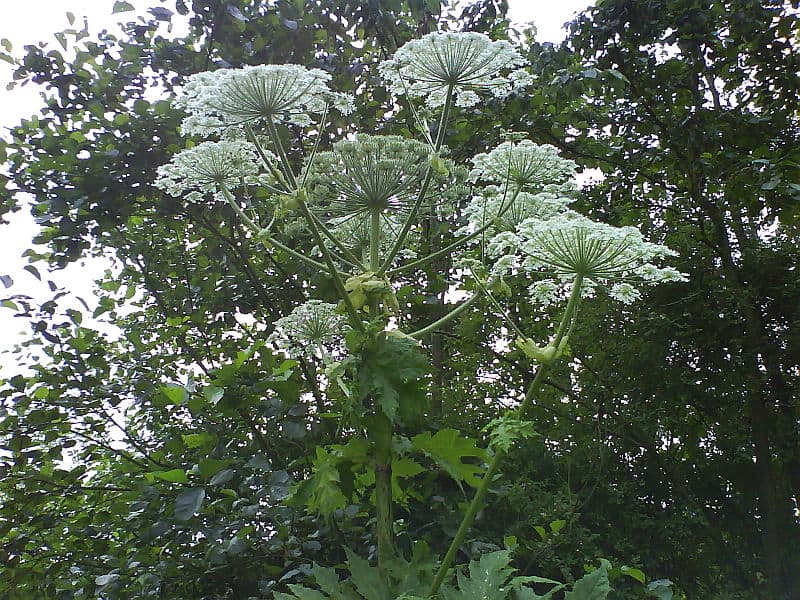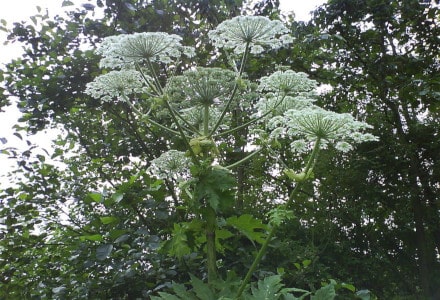
Giant Hogweed Facts
- Perhaps most notably, the astonishing plant known as the Giant Hogweed hides a truly dark secret. The unassuming plant remain quite poisonous. In fact, the innocent looking species actually ranks as one of the most dangerous plants on earth.
- This apparently bizarre fact occurs because of the nature of the naturally occurring sap of the remarkable plant. This ever-present liquid component of the flora evolved quite astonishingly powerful phototoxic properties.
- Not only that, but it’s produced by the plant in extremely copious quantities. Therefore, once on the skin, this powerful natural chemical causes extraordinary amount of damage to human skin. It frequently creates extreme blisters.
- These blisters can also generate severe scarring when exposed to light. Unfortunately, these terrible effects are not short-lived. To the horror of those exposed to it, in some individuals, these scars can last for months, or even years.
- Finally, one more factor makes the Giant Hogweed potentially severely dangerous. Its danger becomes compounded by its strong resemblance to another, harmless plant. This is the Queen Ann’s Lace, a popular ornamental plant.
Related Articles
Giant Hogweed Physical Description
Firstly, the Giant Hogweed typically grows to an amazing height. This vertical growth typically measures between 6.5 ft and 16.5 ft (2 – 5 m), itself an impressive measurement. But, under ideal conditions, the plant has the ability to grow as tall as 18 ft (5.5 m).
Secondly, a grown plant also produces numerous, large leaves. Further, these sometimes have a width of as much as 5 ft (1.5 m). Also, these grow from a strong, thick stem. This develops colored bright green. The leaves also have dark blotches and rough white hairs.
The large, umbrella-shaped head of this surprising plant boasts another astonishing dimension. The head, or crown, can measure as much as 39 in (1 m) across. In addition, the usually relatively thick stems these grow from also contain the thick, highly dangerous sap.
The flowers of the Giant Hogweed generally develop as small. Nonetheless, they also appear in copious numbers. These small but numerous blooms usually show either white or greenish-white in color. The fruits produce large dry seeds that average 0.4 in (1 cm).
- Kingdom: Plantae
- Phylum: Angiosperms
- Class: Eudicots
- Order: Apiales
- Family: Apiaceae
- Genus: Heracleum
- Species: H. mantegazzianum
Giant Hogweed Distribution, Habitat, and Ecology
First of all, the highly prolific Giant Hogweed evolved as native to the Caucasus Mountains, located in Russia. However, the startling species quickly spread to a remarkably wide swathe of western and northern sections of Europe.
Later, it also spread to the countries of Canada and the United States, in North America. There, it quite understandably remains considered an invasive species in many regions. It further displays a remarkable ability to adapt to varied habitats.
However, the remarkable variety of flora primarily thrives in certain, specific types of areas. Therefore, it’s concentrations appear greatest in such regions of the areas it inhabits as coastal areas, along river banks, and in temperate forests.
The plant requires several years of growth before it produces seeds. But, once the Giant Hogweed does, it commonly creates them in vast numbers. In fact, each individual plant typically produces in excess of 20,000 seeds, assuring its ability to spread rapidly.
It’s not just the effects of contact with its sap that serves as the source of what makes it dangerous. The danger is augmented by the speed of its effects. The symptoms typically appear within 15 minutes of contact with the skin and exposure to light. Then, a rash appears.
But this persistent and rapidly-spreading rash can also become quite severe, leaving acid-like burns on the skin. Just a minimum contact with the eyes can cause permanent blindness. Finally, extensive exposure, even just to the skin, can prove fatal in some instances.
Species Sharing Its Range
Check out our other articles on 6 Mysterious Natural Phenomena, Bioluminescent Octopus, Vikos Gorge, Olive Sea Snake, Holywood, Yellow-Eyed Penguin, Begonia, Red Wood Ant

